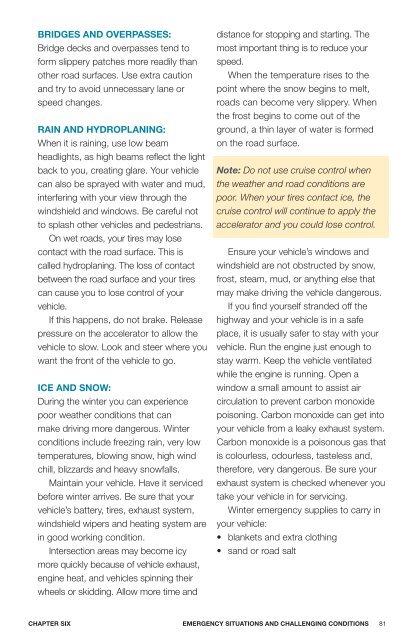DRIVER’S GUIDE
1POl7Ob
1POl7Ob
You also want an ePaper? Increase the reach of your titles
YUMPU automatically turns print PDFs into web optimized ePapers that Google loves.
BRIDGES AND OVERPASSES:<br />
Bridge decks and overpasses tend to<br />
form slippery patches more readily than<br />
other road surfaces. Use extra caution<br />
and try to avoid unnecessary lane or<br />
speed changes.<br />
RAIN AND HYDROPLANING:<br />
When it is raining, use low beam<br />
headlights, as high beams reflect the light<br />
back to you, creating glare. Your vehicle<br />
can also be sprayed with water and mud,<br />
interfering with your view through the<br />
windshield and windows. Be careful not<br />
to splash other vehicles and pedestrians.<br />
On wet roads, your tires may lose<br />
contact with the road surface. This is<br />
called hydroplaning. The loss of contact<br />
between the road surface and your tires<br />
can cause you to lose control of your<br />
vehicle.<br />
If this happens, do not brake. Release<br />
pressure on the accelerator to allow the<br />
vehicle to slow. Look and steer where you<br />
want the front of the vehicle to go.<br />
ICE AND SNOW:<br />
During the winter you can experience<br />
poor weather conditions that can<br />
make driving more dangerous. Winter<br />
conditions include freezing rain, very low<br />
temperatures, blowing snow, high wind<br />
chill, blizzards and heavy snowfalls.<br />
Maintain your vehicle. Have it serviced<br />
before winter arrives. Be sure that your<br />
vehicle’s battery, tires, exhaust system,<br />
windshield wipers and heating system are<br />
in good working condition.<br />
Intersection areas may become icy<br />
more quickly because of vehicle exhaust,<br />
engine heat, and vehicles spinning their<br />
wheels or skidding. Allow more time and<br />
distance for stopping and starting. The<br />
most important thing is to reduce your<br />
speed.<br />
When the temperature rises to the<br />
point where the snow begins to melt,<br />
roads can become very slippery. When<br />
the frost begins to come out of the<br />
ground, a thin layer of water is formed<br />
on the road surface.<br />
Note: Do not use cruise control when<br />
the weather and road conditions are<br />
poor. When your tires contact ice, the<br />
cruise control will continue to apply the<br />
accelerator and you could lose control.<br />
Ensure your vehicle’s windows and<br />
windshield are not obstructed by snow,<br />
frost, steam, mud, or anything else that<br />
may make driving the vehicle dangerous.<br />
If you find yourself stranded off the<br />
highway and your vehicle is in a safe<br />
place, it is usually safer to stay with your<br />
vehicle. Run the engine just enough to<br />
stay warm. Keep the vehicle ventilated<br />
while the engine is running. Open a<br />
window a small amount to assist air<br />
circulation to prevent carbon monoxide<br />
poisoning. Carbon monoxide can get into<br />
your vehicle from a leaky exhaust system.<br />
Carbon monoxide is a poisonous gas that<br />
is colourless, odourless, tasteless and,<br />
therefore, very dangerous. Be sure your<br />
exhaust system is checked whenever you<br />
take your vehicle in for servicing.<br />
Winter emergency supplies to carry in<br />
your vehicle:<br />
• blankets and extra clothing<br />
• sand or road salt<br />
CHAPTER SIX<br />
EMERGENCY SITUATIONS AND CHALLENGING CONDITIONS 81


